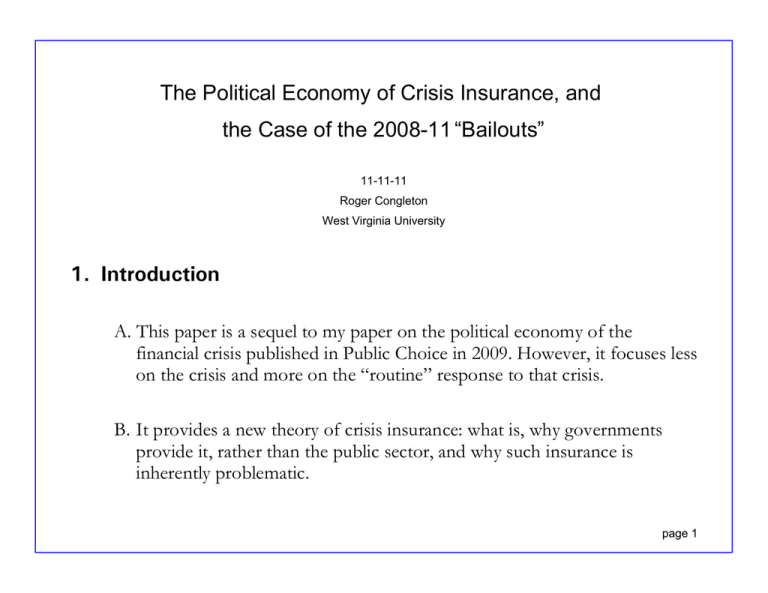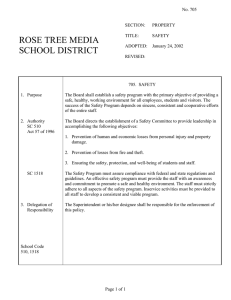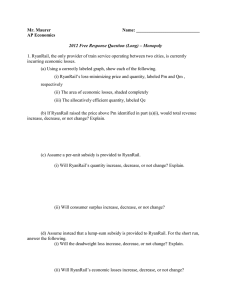The Political Economy of Crisis Insurance, and “Bailouts” 1. Introduction
advertisement

The Political Economy of Crisis Insurance, and the Case of the 2008-11 “Bailouts” 11-11-11 Roger Congleton West Virginia University 1. Introduction A. This paper is a sequel to my paper on the political economy of the financial crisis published in Public Choice in 2009. However, it focuses less on the crisis and more on the “routine” response to that crisis. B. It provides a new theory of crisis insurance: what is, why governments provide it, rather than the public sector, and why such insurance is inherently problematic. page 1 i. Most of the major microeconomic responses to the crisis and recession can be considered new (ex post) safety nets--that is to say crisis insurance programs (a. k. a. “bailouts”). ii. The most famous of the bailouts is the TARP program, but it is not the only example of ex post social insurance provided and it is not the largest one. C. Crisis insurance resembles ordinary insurance in several ways, but differs in important respects, as will be developed in the first part of the talk. i. These properties imply that there will be broad demand for such insurance, yet markets will not be able to provide it. In contrast, governments are in an usually good position to provide that insurance ii. One of the points that I will try to persuade you of is that crisis insurance is in many respects a predictable (natural) response to crises. iii. I will try to persuade you of is that the current levels of crisis insurance are enormous, and that we may not be able to do this again. page 2 2. Ordinary Insurance and Crisis Insurance. A. A few ideas from statistics can be used to analyze the demand for and limits of both ordinary insurance and crisis insurance. Both sorts of insurance are attempts to reduce losses from unpleasant surprises. B. The losses that can be covered with ordinary insurance are those for which both the possible range of outcomes and probabilities of those outcomes are known. i. Conventional insurance companies create reserve funds that funded by insurance premiums. ii. In effect, insurers pay to have access to those reserve funds during times of personal emergencies: a house fire, car accident, or tort claim associated with one’s personal property. iii. In cases in which the range of possible outcomes is too great for a finite insurance fund to cover, limits on the losses covered are part of the policy. page 3 C. Crisis insurance attempts to cover losses that cannot be covered with ordinary insurance. i. A crisis may occur in settings or cases in which the world is so complicated that some events cannot be assigned meaningful probabilities with the data available. ii. A crisis may also occur if the variety of possible events may be so broad that some events are unknown or unimagined because they have never been experienced. iii. The building in which “you” are reading this may begin collapsing from a meteor strike, construction defects, or from an event never previously considered, or perhaps imagined. D. Knowing that unexpected and/or extreme losses do occur allows a variety of steps to be taken to reduce losses, including the creation of “emergency” or “rainy day” funds that can be used to address all manner of losses. page 4 3. Such emergency or “rainy day” funds resemble conventional insurance, but differ in significant ways. A. The difference between ordinary insurance funds and emergency funds can be illustrated by contrasting uniform with normal distributions of losses. i. Within a uniform distribution, complete insurance for any finite number of worse case outcome is possible, because the lowest payoff is bounded. ii. Within a normal distribution, however, complete insurance for any finite number of worse case outcomes is not possible, because the greatest possible loss is unbounded. iii. This implies that private insurance companies that plan to be around for the long run cannot and will not offer such insurance. B. Emergency funds--crisis insurance--attempt to insure against both unanticipated losses and those that go beyond ordinary insurance coverage. page 5 C. Private insurers are unlikely to provide crisis insurance. i. In cases in which very large losses are possible, insurance companies normally insure damages only up to a limit, and often insure only a subset of the events previously experienced. ii. For example, home insurance policies have a maximum payout and routinely exclude losses from floods and revolutions (where multiple, large, simultaneous, claims are likely). Similarly, liability insurance normally is sold with a maximal judgment for a single claim and maximal total for simultaneous claims. iii. Private Insurers recognize that they cannot accumulate sufficient funds to cover damages from all possible combinations of emergencies and/or sell such insurance at a reasonable cost. iv. To routinely insure rare but very high loss events would cause every insurance company to fail in the long run, even though profits may be realized in the period before such low probability events occur. D. Crisis insurance, thus, tends to be provided in a more ad hoc manner. page 6 i. However, for any finite sized emergency fund there is a non zero probability that a loss that will completely exhaust the fund. ii. A rainy day fund can be designed to cover 99% of the possible loss scenarios, but not all of them. E. Voters may thus ask governments to top up private efforts with its far greater ability to provide crisis insurance. i. Governments can produce very large emergency funds, insofar as they are not fully exploiting either their tax bases or lines of credit. ii. Governments may also require ex post “insurance” programs to be funded by those benefiting by imposing ex post fees, something that is difficult for private insurance companies to do. iii. As a consequence, voters may ask government to provide crisis insurance. F. However, just as in the private sector, governmental “rainy day funds” can also be too small to address unusually large crises. page 7 G. Governmental crisis insurance programs are widely supported for both pragmatic and altruistic reasons. i. Unaffected voters may favor such routine responses because they are risk averse and are willing to pay for supplemental, nonspecific, crisis insurance provided by government, because they too may someday face a crisis. ii. Affected voters (and interest groups) have obvious reasons to favor such programs that reduce their losses, especially subsidized programs. iii. Altruism also evidently plays a role as evidenced by the broad private and public support for victims of domestic and international disasters. H. If this line of argument is correct, one should see democratic governments routinely provide “emergency funds” to limit the losses of a wide variety of extreme losses that are not (and cannot be) covered by ordinary insurance programs. I. There is a good deal of evidence that democratic governments do so. page 8 i. Historically, democratic governments have routinely provided support for those harmed by floods and earthquakes. ii. And, for nearly as long as there have been business cycles, governments have provided support for those harmed in economics crises. iii. The loss limiting programs developed in response to the 2008 financial crisis provide useful illustrations of government provided crisis insurance (bailouts) --one that is unusual only for being so large. iv. They also suggest that only limited coverage can be provided. 4. A brief overview of the financial crisis of 2006-08 A. The 2008 crisis was an unpleasant surprise for most of us. And few of us were fully insured for the damages associated with it. i. A wide variety of new crisis insurance was extended to aid a fairly wide cross section of the victims. ii. Although not everyone was covered by the umbrella and all losses were not eliminated, the losses of a very wide range of asset owners were reduced by such policies. page 9 B. In my 2009 paper, I argued, as many others have, that the proximate cause of the recession and financial crisis was the piercing of a housing bubble. i. That papers suggests that the bubble was magnified by various public policies, but was not caused by it. ii. The collapse of housing prices removed about 6 trillion dollars of wealth from the economy. iii. This paper suggests that part of the problem was that private insurers thought they were providing ordinary insurance, but were actually providing crisis insurance. C. Built on top of the housing bubble was rather large financial sector created by securitizing the mortgages used to purchase the “overpriced housing.” i. The securitized credit market was a new source of credit, it was essentially grounded on real estate prices, and was enormous. ii. Risks in that market turned out to be under priced and over leveraged, in part because the various insurance instruments used to limit losses could not really do so when housing prices began to fall at unprecedented rates. page 10 Figure 1: Case‐Shiller Housing Price Index 1987‐2010 200 180 160 140 120 100 80 60 40 20 0 1 9 8 7 1 9 8 8 1 9 8 9 1 9 9 0 1 9 9 1 1 9 9 2 1 9 9 3 1 9 9 4 1 9 9 5 1 9 9 6 1 9 9 7 1 9 9 8 1 9 9 9 2 0 0 0 2 0 0 1 2 0 0 2 2 0 0 3 2 0 0 4 2 0 0 5 2 0 0 6 2 0 0 7 2 0 0 8 2 0 0 9 2 0 1 0 C‐S Housing Price Index page 11 Figure 2: Delinquency Rates at All Commercial Banks 1991-2010 (quarterly, seasonally adjusted, FRB) 12 10 8 6 4 2 0 19 91 Q 1 19 92 Q 1 19 93 Q 1 19 94 Q 1 19 95 Q 1 19 96 Q 1 19 97 Q 1 19 98 Q 1 19 99 Q 1 20 00 Q 1 20 01 Q 1 20 02 Q 1 Delinquency Rates Morgages for Single Family Homes 20 03 Q 1 20 04 Q 1 20 05 Q 1 20 06 Q 1 20 07 Q 1 20 08 Q 1 Delinguency Rates All Loans 20 09 Q 1 20 10 Q 1 page 12 D. As housing prices fell and default rates rose, the value of mortgage-backed securities and other securities based on them fell, because risks were reassessed and leverage throughout the financial system was reduced. i. The collapse in MBS security prices reduced wealth in the worldwide financial sector by on the order of 5 trillion dollars. ii. As it became clear that MBS securities were not the low risk assets they had expected, portfolio managers began to adjust their portfolios to reduce risk, that they had never intended to include. iii. Asset bubbles also burst in stocks and futures markets as investors all rebalanced their portfolios in pursuit of safety. Indeed, the pursuit of safety was the reason that the new bond issues of the U.S. government could be sold on very favorable terms. E. The collapse in MBS values was reinforced and accelerated by widespread bankruptcy among mortgage and MBS insurers. Mortgage insurers, including Fannie and Freddie, began to fail, in part because they thought that they were providing ordinary insurance, when in fact they were providing crisis insurance. page 13 5. Crisis Management and Emergency Funds A. The political economy of crisis management suggests that in response to a crisis, we would see the expansion of existing safety nets and the creation of new ones, without much deliberation, and in many cases in a manner that profits fairly narrow but well placed groups (financiers). B. This prediction is borne out in the responses that we observed. i. Both the Treasury and the Federal Reserve Bank of New York were involved in the creation of new safety nets, sometimes as part of their macro-economic policies, but often for entirely micro-economic and political reasons. ii. All of the resources committed by the Treasury were or were to be borrowed. iii. The resources used by the Fed were also in a sense debt finance insofar as treasury holdings were sold to purchase mortgage backed securities. iv. As is developed below, more than $3 trillion of new safety net programs were created. page 14 C. Because it is difficult to create new solutions whole cloth, especially on short notice, there will be a tendency to use familiar solutions, even if they may not be entirely appropriate. i. The new safety net programs can be considered examples of such conduct. ii. After storms and floods and many previous financial crisis various forms of ex post “bailouts” and other loss limiting programs are routinely adopted. Many in the financial sector argued that the problem was that prices were either falling too quickly or were too low. If so, why not create new programs that would increase those prices (or establish a floor) or slow down their fall. iii. It is thus not surprising that a wide range of policies were adopted to prop up housing values, mortgage backed securities, and financial firms holding more of those securities than they (ex post) wished to, as with TARP and the Fed’s purchase of Mortgage Backed Securities. page 15 D. Crises are also times when mistakes can be exploited by interest groups. i. If some kinds of mistakes are more common than others, persons who may profit from particular mistakes will lobby in favor of them. ii. Given the above, it is of course entirely predictable that those whose assets are falling “too quickly” will lobby for “price support” and other safety nets. Indeed, who would lobby in favor of lower house prices? iii. In this case, there was an alignment between well-meaning crisis management efforts and the financial interests of a broad cross section of asset owners and financial institutions. Such strategies may not be the best strategy if the prices were originally well above their long run equilibrium values, that is to say if a bubble really existed. But they would tend to be adopted both because they are familiar, that is to say similar to previous efforts to reduce losses after a crisis. It seems clear that the new safety net programs created a calmer time in which firms, individuals, and government officials could adjust to the new circumstances and come up with better ideas and policies. page 16 E. Because of the need for rapid decisionmaking, crises are also times when an effective agenda setter is more likely to get his or her way. i. Secretary Paulson’s 700 billion dollar TARP proposal is a case in point ii. No other number was seriously entertained. iii. This was partly a conscious strategy adopted by Paulson: “...we needed to sell TARP hard. As Treasury staff negotiated with Congressional Democrats on the particulars, we felt we could not show any doubts about our approach or any openness to other ideas. Whenever anyone on the Hill asked the Treasury team if they had any other plans, the response was: “This is the plan.” (Paulson 2010: 280) F. The urgency of rapid decisions implies that focusing attention on a particular option may be sufficient to induce that option to be adopted, because of the urgent need to respond to a crisis. A very wide range of policy decisions were that extended existing programs and created new crisis insurance programs, but only TARP received very much press attention. page 17 6. Table 1 provides a conservative list of the major responses to the fiscal crisis and recession, with a focus on cases that can be considered ex post “crisis insurance” or “safety nets” created during 2008-10. A. The numbers are not cash flow numbers nor are they insurance obligations, both of which are much larger than the numbers listed. B. Only funds directly used in these programs are tabulated. C. Still, the amounts are very large by historical standards. page 18 Table 1: Partial List of New or Extended Safety Net Programs 2008-10 Date Safety Net Funds Committed or Cost (billions) March 2008 Maiden Lane 1 (F) $28 March 2008 Asset-Swaps for Financial Firms (TSLF) (F)* $250 July 2008 New Lines of Credit for Fannie and Freddie (C) $150 Support for Money Funds (AMLF) (F)* $170 October 2008 TARP (C) $700 November 2008 Federal Reserve Announces it’s TARP (F) $500 November 2008 Maiden Lane 2 (F) $22 November 2008 Maiden Lane 3 (F) $30 February 2009 Second Stimulus Bill’s Safety Nets (C) $200 March 2009 Federal Reserve Expands its Tarp Program (F) $725 May 2009 FDIC Receives Extended Line of Credit (C) $500 2008-10 Extended Unemployment Benefits (C) $100 September 2008 Total $3,375 * Amount loaned during first month of program page 19 D. Both the Treasury and the Federal Reserve Bank of New York were involved in the creation of new safety nets, sometimes as part of their macro-economic policies, but often for entirely micro-economic and political reasons. E. Resources committed: over 3 trillion dollars i. All of the resources committed by the Treasury were or were to be borrowed. ii. The resources used by the Fed were also in a sense debt finance insofar as treasury holdings were sold to purchase mortgage backed securities. F. To put the numbers in perspective, i. The entire federal budget was about $2.7 trillion in 2007, before the crisis began. ii. The entire publicly held debt was $4.2 trillion in 2007. page 20 7. On cost and the limits of crisis insurance A. The above response shows why only government can provide large scale crisis insurance. It also suggests that even the crisis insurance proviced by governments have limits. B. There are several problems associated with all crisis insurance programs. i. First, as with private insurance, there is Moral Hazard: the price of crisis insurance is rarely directly linked to the risks insured. It really cannot be priced ex ante and is difficult to price ex post. This problem tends to be larger for government provided insurance, because most safety nets are subsidized by taxpayers. ii. Second, it is actually impossible to fully fund a large crisis insurance fund, which means that only ex post payments are possible. (Consider the “lock box” for social security.) page 21 iii. Third, this implies that funding will tend to be ex post. Expose financing is often politically difficult to do. (Banks lobbied for the FDIC to borrow extra money from the treasury (taxpayers) rather than for higher fees to pay for their higher redemption rates during the recession.) iv. Deficit finance creates other problems associated with leverage, and may reduce the ability of governments to provide future crisis insurance. C. If these and other systemic risks are under priced, there should be upward trends in the outlays of standing crisis insurance programs. There is some evidence of this in the US, as with flood insurance, insurance for the S&L industry prior to 1990 (FSLIC was declared insolvent in 1987 by the GAO), and the FDIC today. Efforts to provide greatly extended safety nets for major banks continue in Europe today. Two national governments were essentially bankrupted by their crisis insurance commitments: Iceland and Ireland. page 22 Losses Covered by Federal Flood Insurance (millions of 1982 dollars) 2000 1800 Covered Losses 1600 1400 1200 1000 800 600 400 200 0 1978 1983 1988 1993 1998 2003 2008 Year Covered Flood Losses page 23 24,000 20,000 16,000 12,000 8,000 4,000 0 1986 1990 1994 1998 2002 2006 2010 Losses page 24 8. Can Crisis Insurance be Provided without shifting the risk to tax payers? A. Although it is not possible to fully fund a large insurance program, it is possible to fund a small reserve and use pay-as-you-go funding for losses. i. The FDIC does this for banks. ii. The same principle could be extended to other financial markets and contributions-insurance fees-taxes based on risk. iii. This does not eliminate all moral hazards, but does reduce them and also reduces unfunded (and thus subsidized) crisis insurance. B. In addition, fees for the industry or regions benefiting from crisis insurance can be collected after it is provided. Similarly, the support provided can be in the form of loans. i. Thus, much of the insurance provided to limit losses from the 2008 financial crisis seems to have been developed with moral hazard and funding issues in mind. page 25 ii. However, much has not been, as evidenced by the extraordinary expansion of US government debt (and that of most European Countries) in the past three years. iii. If we accept the arguments of Bernanke, Paulson, and Geithner, the use of crisis insurance in conjunction with textbook macroeconomic policies reduced the depth of the current recession C. The next time, however, we may not be able to provide nearly as much crisis insurance. i. If one compares the S&L and MSB crises, it seems likely that the next crisis will be larger than the present one because of moral hazards inside and outside government. ii. If so, there will be large ex post demands for crisis insurance, but no way to fund it through borrowing. It bears keeping in mind that about half of the present publicly held debt is held outside the United States (About $4 of $9 trillion.) page 26 In conclusion, it could be said that public finance is no longer a boring subject. 9. Thanks for your attention. page 27






